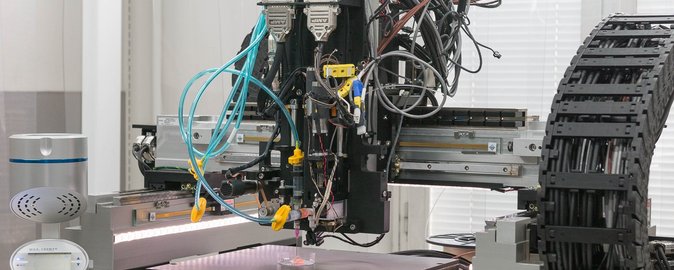- Education
-
Research
Current research
Talent
-
Collaboration
Businesses
Government agencies and institutions
Alumni
-
About AU
Organisation
Job at AU
A technique for printing soft parts using a 3D printer which can, among other things, replace transplanted tissue, has just been outsourced to the company Hyamedix. Assistant Professor Dang Quang Svend Le from Aarhus University and Aarhus University Hospital is the man behind the invention.
2019.08.08 |

The 3D printer can print a gel-like biological material called hyaluronate, which is naturally occurring in the body in e.g. connective tissue. It can be used for research and medical treatment.
A licence agreement between Aarhus University and the Danish biotech company Hyamedix has just been finalised. The agreement gives the company access to technology which Assistant Professor Dang Quang Svend Le has developed and patented for the production of what are known as a 3D printed hydrogel matrix.
The hydrogel consists of hyaluronate, which is a gel-like biological material that is found naturally throughout the body. The technology can potentially make it possible to 3D print tissue which would otherwise be taken from other parts of the body and transplanted. The printed material can similarly be used for healing wounds and cosmetic surgeries. Furthermore, the hydrogel can be used to test medicine by growing liver cells in a synthetically grown mini liver instead of a petri dish, making it faster, easier and cheaper to test medicinal products – while also providing more accurate results.
Dang Quang Svend Le has a background in both medicine and bioengineering and works as a researcher at the Department of Clinical Medicine at Aarhus University and at the Department of Orthopaedic Surgery at Aarhus University Hospital.
He has years of experience of working with 3D printing and during this time, he has made a habit of involving the industrial sector in his research from the earliest stages.
"Really, the whole purpose of clinical research is to get that research out there where it can be useful, rather than it just remaining in the academia’s closed circuit, where we publish - with that being the end of it. We hope that the results of our research will soon be available for sale and that everyone who requires this type of medical equipment with be able to buy it," he says.
Collaboration between researchers and industry is often talked about – but less often put into practice. Dang Quang Svend Le wants to help ensure that the two worlds become better at working together – and to inspire others to follow the same path.
Early in the process he makes sure that any academic notions about the industry’s needs are actually interesting for the industry and that they have a chance of becoming viable products under commercial conditions. He therefore pitches inventions to potential licensees, as well as highlighting how useful it has been to work closely with private companies, for example under the Innovation Fund Denmark’s Innobooster programmes.
"When you try to 'sell' research, it’s worth remembering that the buyers who assess funding applications are often neither research colleagues nor experts but cold, calculating commercial research managers who mostly think about the bottom line," says Dang Quang Svend Le.
"And the company's needs are not just the published research results, but as in this case, ten years of development of both research results and end user experience – of course with input from medical doctors and surgeons. Doing all of this also means you take time out of 'proper ' research, which of course has the publication of articles as its focal point," he says.
Dang Quang Svend Le has previously been honoured for his talent for innovation. In 2014 he received the Strategic Research Award from the Ministry of Higher Education and Science in recognition of his strategic research and its particular innovation potential. At that time, Dang Quang Svend Le had been the leading inventor of four patents in three years.
The university and Dang Quang Svend Le now have a licence agreement which means that Dang Quang Svend Le will pass on the data, methods and procedures which he has developed at Aarhus University to Hyamedix, a company founded by former Novozymes employees. The rights belong to Aarhus University, and Dang Quang Svend Le has no problem with this set-up.
"It is Aarhus University that has made me an inventor and made my research possible, and the university has also taken on the risk that is always associated with the early stages of product development projects, so I think that this is really all right," he says.
Hyamedix expects to achieve DKK 200 million in revenue after five years.
An important tip from Dang Quang Svend Le is that researchers at Aarhus University ought to make use of the Technology Transfer Office, which is Aarhus University’s office for technology transfer and collaboration with business and industry. The Technology Transfer Office works to ensure that selected research projects and products are targeted directly at business and industry right from the outset so as to ensure there is an innovation process after which the products can be sold on the global market.
"Our contracts state that the Technology Transfer Office must be involved when relevant, and they have extremely competent people to help you," says Dang Quang Svend Le. He also recommends contacting the Technology Transfer Office as early as possible.
Assistant Professor Dang Quang Svend Le
Aarhus University, Department of Clinical Medicine and
Aarhus University Hospital, Department of Orthopaedic Surgery
Mobile: (+45) 4063 3437
Email: dqsl@clin.au.dk